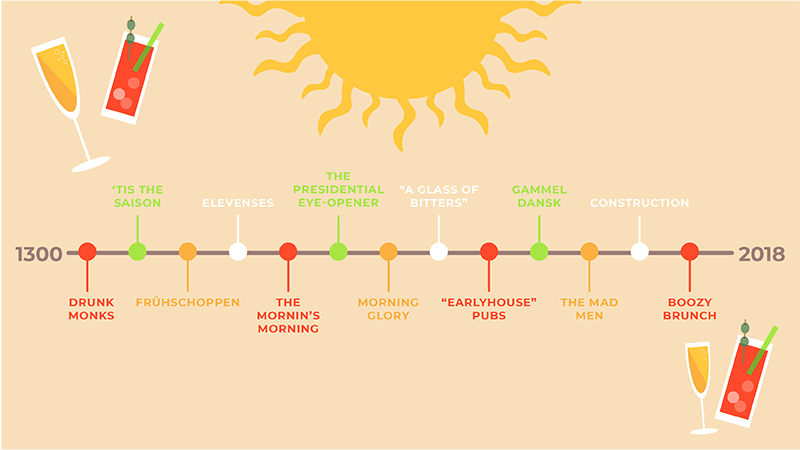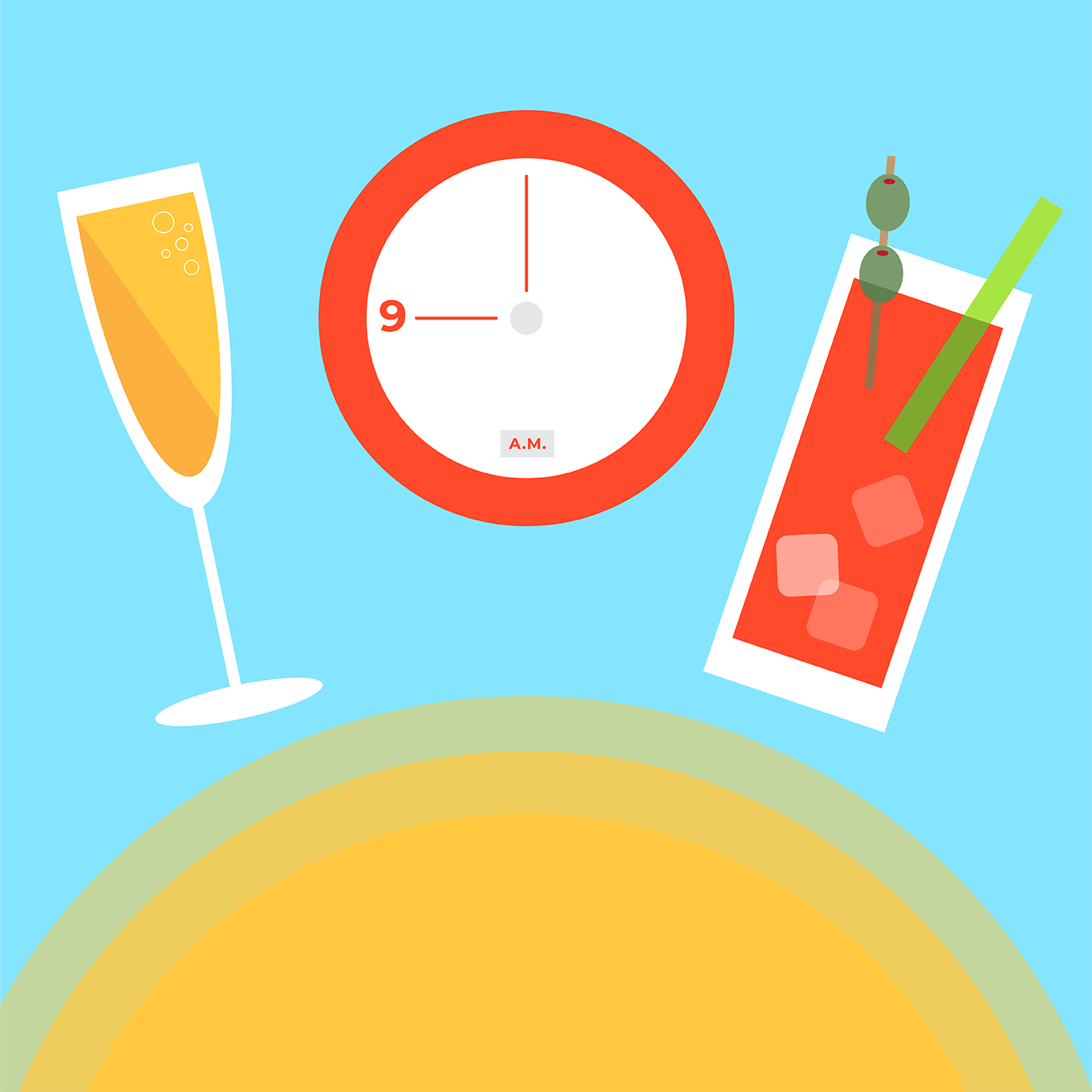
“It’s 5 o’clock somewhere!” lamely jokes the guy in your office who thinks he’s being naughty for having a light beer at a 3:30 p.m. offsite meeting.
Today his coworkers might snicker at his so-called transgressiveness. Yet for most of history, drinking before 5:00 p.m. was perfectly acceptable, if not necessary. Many people drank in the morning because there was nothing much else to drink. Other beverages — like water — were dirty and could potentially kill you.
Yes, throughout time there have been plenty of instances where drinking before noon wasn’t just perfectly acceptable, it was a means of survival.
Drunk Monks
If the archetypal morning drinker these days is a disgruntled third-shift worker, back mid-millenium, it would have been a clergyman. It makes sense, as monasteries were where the majority of beer and wine was made at the time.
German monks were producing beer as early as the 14th century. By 1634 the friars at Neudeck ob der Au (Paulaner Brewery) in Munich were slamming morning dopplebocks during Lent. Acting as liquid bread during this 46-day fast, it’s no wonder that their strong beer, named salvator, translates to “savior.”
Meanwhile, Belgian monks had begun producing their own table beer. Called “small” beers, these were low-ABV (under 3 percent) thirst-quenchers they could bring to the breakfast or lunch tables to enjoy with their meals. Some monastery records show they were allowed up to a gallon of ale per day. Which meant… they were probably starting early.
’Tis the Saison
Eventually, as commercial agriculture developed in Europe, morning drinking became an integral part of blue-collar life. In the Wallonia region of southern Belgium, and then northern France, farms started brewing their own beers in the winter so it would then be ready to drink in the summer, during harvest time. These pale, light, and slightly funky beers known as “saison” and “bière de garde” were refreshing, fortifying, and safe to slug all day by the workers. Historian Léo Moulin, in his book “Eating and Drinking in Europe: A Cultural History,” estimates that farm workers drank around 5 liters of beer per day during the Middle Ages.
Frühschoppen
Translating to “an alcoholic drink before midday in company,” Frühschoppen has been part of Bavarian life in Germany and Austria since perhaps the 16th century. These pre-noon beers were traditionally served after church on Sundays and holidays, and were usually a weissbier (wheat beer). The beer was also often accompanied with food like wurst and pretzels.
In 2015, President Barack Obama even hoisted a pint with Chancellor Angela Merkel at 11 a.m. one morning. Unfortunately, his beer was non-alcoholic.
Elevenses
The English have had the tradition of “elevenses” since the early 1800s — it was a break at, duh, 11:00 a.m. during which the upper crust would have a small snack and a spot of tea. American workers of all sorts quickly copied the tradition and improved it, adding the one thing that improves everything: whiskey. In fact, many employers were expected to supply their workers with the whiskey for getting blotto on the clock.
By the time that the Industrial Revolution was in full swing, and government employment oversight became a bigger deal, elevenses was gone. Work has been pretty boring ever since.
The Mornin’s Morning
Between the Civil War and World War II, many American urban sophisticates still enjoyed an eye-opener, though, which they poetically called a mornin’s morning.
Washington D.C. politicians of the 1800s, like Colonel Joe Rickey, especially liked an early-hour libation — which, for him, was typically bourbon on ice topped with seltzer from a siphon. In 1883, a bartender at Shoomaker’s in Washington added a lime to Rickey’s drink, thereby inventing the Rickey cocktail.

The Presidential Eye-Opener
Oddly, the U.S. presidency has also produced a long roster of morning drinkers. (Well, it is a tough gig.) John Adams famously downed a “jill of cider” from a tankard (picture a beer stein) with breakfast every morning — he thought it diluted the overnight phlegm and bile in his stomach. Harry Truman threw back a shot of Old Grand-Dad every day after his morning walk. Gerald Ford often had a dry Martini before lunch. Across the pond, Prime Minister Winston Churchill enjoyed starting his day with German white wine, which the Brits call “hock.”
Morning Glory Fizz
There was actually a time where there were morning cocktails besides those “bottomless” and garnished with celery stalks. Like the Morning Glory Fizz, first proposed by Harry Johnson in his 1882 “New and Improved Bartender’s Manual.” The drink included a wine glass of Scotch, 3 or 4 dashes of absinthe, lemon and lime juices, sugar, and an egg white, then topped with seltzer.
As Johnson wrote, the “drink must be drank as soon as prepared, so as not to lose the effect of it. The author respectfully recommends the above drink as an excellent one for a morning beverage, which will give a good appetite and quiet the nerves.”
In the 1887 update of Jerry Thomas’s seminal “Bartenders’ Guide,” Thomas introduced a Cognac-based riff on the morning fizz. Called the Saratoga Brace-Up, it used less absinthe, subbed in Cognac for Scotch, and used a whole egg.
“A Glass of Bitters”
As cocktail historian David Wondrich discusses in his acclaimed “Imbibe!”, the Sling — alcohol, often gin, with a little sugar and a little water — was popular during Singapore mornings from as early as the late-18th century. He writes that it “wasn’t just a hangover cure… It was an everything cure.” It also allowed people to act like they weren’t getting buzzed at breakfast.
As Wondrich concludes, “The morning Bitters-and-Sling man could pretend, not least to himself, that he wasn’t a morning dram drinker (which would be bad) and that he was only following the path of wisdom by taking a little preventative medicine.”
“Earlyhouse” Pubs
As recently as 100 years ago, many English and Irish pubs served drinks throughout the morning, and a beer with breakfast was expected for all sorts of workers.
Called “earlyhouses,” and first officially licensed in 1927, they typically opened around 7 in the morn, and were meant to provide fortification to help get early a.m. workers (like, say, milkmen, greengrocers, dock workers, and fishermen) through their dreary days. These types of pubs lasted well into the mid-20th century and, though a few earlyhouses still exist in London and Dublin, they are now said to be most popular with tourists.
Gammel Dansk
This Danish bitter liqueur was first brought to market in 1964, and it almost immediately became an indelible part of the country’s morning routine. Made with 29 herbs and spices, the libation has a note on the label reading “Gør godt om morgenen, efter dagens dont, under jagten, på fisketuren eller som apéritif” (“Enjoyable in the morning, after a day’s work, when hunting or fishing, or as an apéritif.”)
Indeed, that is the way it was roundly utilized until, as in America, morning drinking became less acceptable in recent years. Nevertheless, shots are still taken at weekend brunches and during early-morning celebrations of weddings and birthdays.
The Mad Men
The prestige drama “Mad Men” did wonders for the rye industry and reintroduced many Americans to Old Fashioneds. It’s also a touchstone for the culture of all-day drinking for many folks. But was it really like that?
According to veteran ad executive Jerry Della Femina, three-Martini lunches were, in fact, the norm. While morning drinking wasn’t quite as common, most execs kept a well-stocked bar in their offices, just in case.
As Della Femina told ABC News, “Invariably, one or two guys would come in[to my office] at 9:00 a.m., pour a shot and slug it down. It was a business of drinking.” He says this aspect of advertising culture was mostly gone by the 1980s.
Building Change
One of America’s last bastions of acceptable morning imbibing was among New York City construction workers. For most of the 20th century, they could start their shifts or relax on their breaks with a brew.
Of course, construction work is the rare gig that is done in public. Thus, when the city outlawed public consumption in 1979, seemingly the jig was up. Then again, as City Councilman Frederick E. Samuel noted at the time, “We do not recklessly expect the police to give a summons to a Con Ed worker having a beer with his lunch.”
Nowadays, you’ll still see a construction worker with the occasional brown-bagged beer breakfast, but not as much as the glory days of the past. And since they are building tall stuff, maybe that’s a good thing?
The Final Frontier
Today, in 2018, there are only a few times and places where conventional members of society can still drink in the morning with impunity. Most holidays are generally fine (though probably not, like, MLK Day or Yom Kippur). Sporting event tailgates are cool, too. Airports, no sweat.
But, really, the only regular time and place normal folks can get blotto in the morning is at weekend brunch. This is a more recent occurrence than you think — Mimi Sheraton of The New York Times cites hardcore brunch boozing first becoming a citywide staple around 1977. That makes sense, as the idea of “bottomless” Mimosas and Bloodys on a Sunday may very well have arisen because all the aforementioned options of morning imbibing had already been scrapped, if not totally vilified, by society. Life finds a way.
